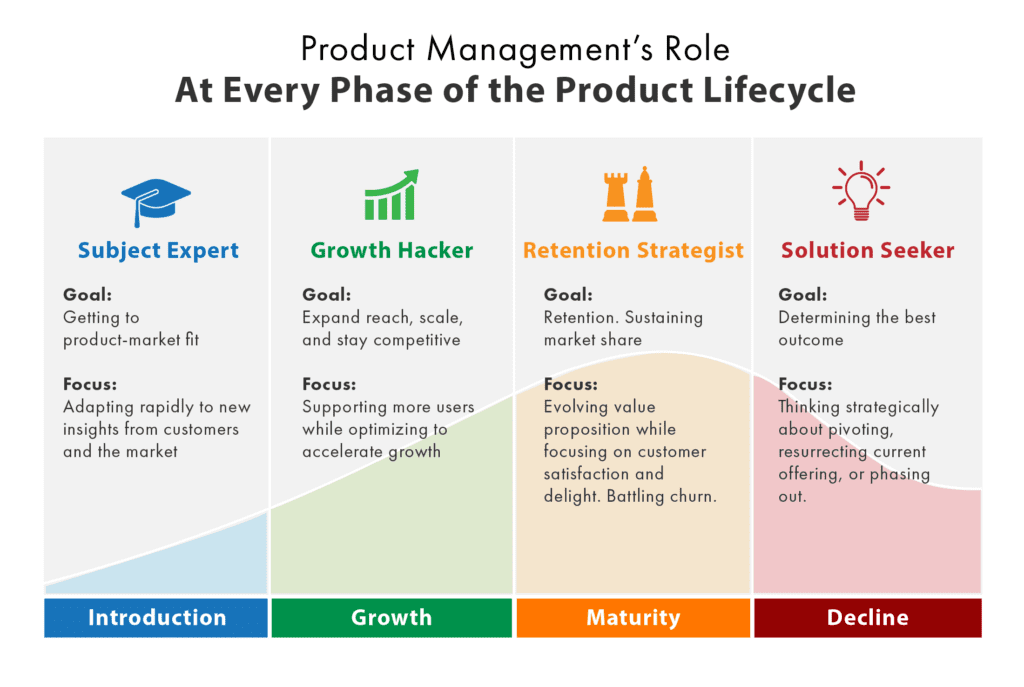Every product has a lifecycle that consists of various phases. And the demands placed upon a product manager often vary depending on the lifecycle stage their product is in. The product manager role requires the use of different mental muscles and skills for driving it to the next step in its lifecycle while being simultaneously led by the product strategy.
Identifying, acknowledging, and understanding which phase a product is in is just as critical as knowing what each stage requires. This post will define each phase—Introduction, Growth, Maturity, and Decline—and highlight what product managers should be focused on during each period.

Product Lifecycle Phase #1: Introduction
All products start somewhere, whether they’re spinoffs, or brand extensions of a popular offering, or something completely new from an unknown startup. Regardless of its origin story, a new product faces a particular set of challenges, some of which require the attention of its product manager.
What should product managers of newly-introduced products focus on?
When a new product is also novel (meaning it’s the first in its category), the main challenge is generating demand. People aren’t used to buying this product so the focus is on creating awareness and communicating its benefits so people want to actually buy it. This is also a critical juncture in confirming product-market fit; while market research and early trials may have corroborated your hypotheses, the validation comes when users actually spend money buying and using it.
Read the Product-Market Fit Book ➜
Product teams must be nimble and reactive during this phase since there’s often a short runway to determine whether the product has legs or if the company should cut its losses and move on. Emphasizing different aspects of the value proposition, highlighting various features, and quickly quashing points of friction are all essential to keeping a newborn product viable.
And because there’s no competition, a key choice must be made regarding pricing—do you sell it for a higher price to eager early adopters because no other companies or products exist to undercut yours, or do you offer it for a low introductory price to help convince as many people as possible to give it a try?
Once the product begins gaining a bit of traction, product teams must understand who’s really using it and which aspects of the product are resonating most. Personas may evolve and roadmap priorities can shift based on this early usage data from real customers.
And while introduction may not be the most expensive phase of a product’s lifecycle, it is definitely its least profitable, since sales and revenue will be slight compared to the high costs of initial research and development, larger marketing expenses, and low sales totals. When those sales volumes start ramping up, a product is ready to graduate to its next phase.
Although product management may not be performing or directly managing many of the go-to-market tasks pivotal to this phase, they still serve an important role here. As the in-house subject matter expert, their job is explaining to everyone relevant what the product can actually do (which isn’t always obvious when it’s new) and why someone would want to use it. They should be a readily available resource to the marketing and sales organizations during this phase.
Product Lifecycle Phase #2: Growth
Once sales increase and the product has proven it has a market, it enters into its second phase. This is the stage when many companies really invest in marketing since they’ve identified which messages are resonating and which channels are best suited to reach the demographic that purchased early on.
Profit margins typically increase during this phase as economies of scale begin to kick in and (when applicable) manufacturing costs decline per unit with higher volume and fewer defects. But along with more sales comes more competition, as other companies realize there’s a valid market for the product and introduce their own offerings.
What should product managers focus on for growth phase products?
This influx of competitors can drive prices down to either match or undercut alternative products or expand the potential market of buyers. Product managers must manage this balance carefully to remain competitively priced without giving away margin unnecessarily.
The other key challenge for product teams is identifying who beyond their initial early adopters might want to purchase their product and which new features or changes are required to bring in that additional business. With this data in hand, they can prioritize the product roadmap to maximize sales during this land-grab growth phase.
And with so much money being spent on marketing and advertising that directly fuels growth, product managers must continually remember that some of that revenue and profit should be reinvested in product development. This is necessary in order to continue iterating and improving the product, not to mention ensuring it can continue scaling to support ever-increasing usage.
Because so much of “growth hacking” is all about mining data to uncover patterns and trends, this is a phase where a product manager’s technical skills can really shine and be of use.
Product Lifecycle Phase #3: Maturity
Product maturity might sound like a great goal, but for a product, it’s not always nearly as attractive as the growth phase. At this phase, new customer growth tapers off, competitors gobble up market share, and profits decrease as more companies claim a piece of the same pie.
Most who wanted to buy a product in your category already have and the influx of new buyers to the market slows to a trickle. The biggest challenge now is retaining as much of your customer base as possible while combating churn and attrition.
What should product managers focus on during a product’s maturity phase?
For product managers, the maturity phase is an opportunity to reduce costs while continuing the differentiation of your product from the rest of the market. Lowering the cost of goods sold (COGS) is all about creating more efficiency in every aspect of the operations, from keeping the development team lean and mean to automate customer support and onboarding tasks.
To stand out in a crowded field, product managers must be very selective in which features they invest in and how their value proposition evolves. The focus must be on enhancements with a high ROI that either enables them to charge current customers more for new add-ons or that opens up a new target market with a unique offering.
The product team’s focus on metrics is critical during the maturity phase, as it can make the difference between a longer maturity period with only minimal decline or falling off a cliff. Understanding user behavior and which actions result in continued usage and payment versus those that precede churn and abandonment can drive both feature development and prioritization discussions.
Focusing on user behavior may lead to the development of proactive nurturing campaigns, user-specific promotions, and pricing changes–all of which are designed to keep current customers happy and satisfied for as long as possible.
Product Lifecycle Phase #4: Decline
Everything eventually heads downhill, and your product won’t be the exception. The decline can be precipitated by either the entire market for a product dwindling—either due to a replacement solution or a reduction in overall demand—or it can just be specific to your offering, with competitors having surpassed your product in popularity, affordability, and/or functionality.
What should product managers focus on during a product’s decline?
Understanding which scenario is driving the decline is key to how a product manager handles the situation.
When the entire market is shrinking, product managers must explore how they can leverage existing technology and brand equity to pursue an entirely new market. While a decline specific to only your product may necessitate a different type of course correction.
While this kind of late-stage product pivot doesn’t often pan out, there are plenty of examples of companies that took their current assets and found success beyond their initial product offering and market. Some examples include:
- Apple switching its focus from a stagnant desktop computer offering to mobile devices
- Microsoft embracing the cloud, gaming, and subscription services while abandoning its smartphone aspirations
- McDonald’s selling healthier foods and salads to meet changing eating habits.
Another way product managers can stave off a rapid decline is offsetting churn with resurrection; figuring out how to get former customers to come back again or prompt inactive users to restart and resume activity. While much of this may be executed by marketing, product teams can play a key role in identifying the traits of former users with the most potential to come back and informing the messaging with which features those returning users tend to utilize.
Of course, there is one final responsibility product managers have. In the event, a declining product is beyond rescue, sunsetting and end-of-life processes become important. While not much fun, there’s an obligation—sometimes a legal and fiduciary responsibility as well—to provide as painless a transition as possible for remaining customers when it’s time to pull the plug. This may include exporting or transferring customer data, issuing refunds, finding new vendors and solutions for long-time customers, and providing excellent customer service to preserve those customer relationships for whatever lies ahead.
Conclusion: Enjoying the ride for as long as possible
Progressing through product lifecycle phases is generally unavoidable; while some companies and brands may last centuries, most products do not as they are replaced by better, cheaper, or simply different things. As a product manager, your job is to get your product to evolve from the introduction phase, maintain growth, squeeze as much value as you can, then minimize decline.
Of course, a common mistake is not acknowledging where in the lifecycle a product currently resides and tending to it appropriately. Jumping the gun on growth or denying the reality of a decline can turn a gradual descent into a free fall, cutting years of profit from the product’s overall lifespan.
Knowing that you’re fighting a battle every product eventually loses can be daunting. But the arc of a product lifecycle can last decades, so there’s no reason to fear the inevitable. The decisions you make and the job you do during each phase can significantly influence the length and success of each stage. Just as importantly, the skills a product manager needs change from phase to phase, so it’s imperative to continually demonstrate that you’re up to the particular task at hand, since not everyone is adept at changing gears when a product evolves to its next stage.




